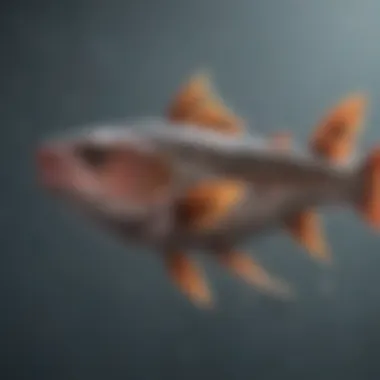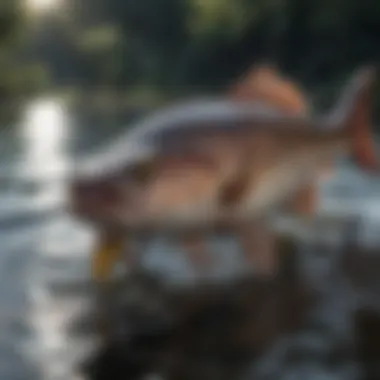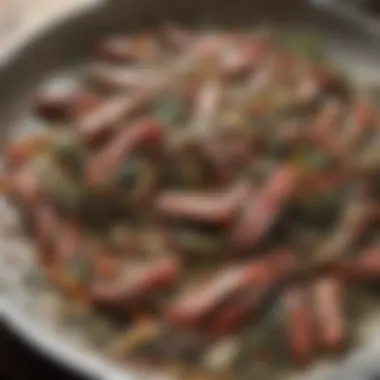Understanding Pollock: A Comprehensive Exploration


Intro
Pollock is an essential fish species that plays a significant role in marine ecosystems. This article aims to present a thorough overview of Pollock, exploring its biological features, ecological role, culinary usage, and the pressing need for sustainable fishing methods. Understanding these elements is key to appreciating the importance of this species in both marine biodiversity and human consumption.
Here we will delve into the various characteristics that define Pollock, highlighting its significance and the challenges it faces in today's world.
Animal Species Profile
Prelude to the animal species
Pollock refers mainly to two species: Atlantic Pollock and Pacific Pollock. Both species belong to the Gadidae family, which also includes cod. They inhabit cold waters, where they are often found in large schools, contributing to their importance in both the ecosystem and commercial fisheries.
Physical characteristics and appearance
Pollock can be identified by their elongated bodies, which are typically dark green to brown on the back, with lighter sides and a white belly. adult Pollock can grow up to 90 centimeters in length and weigh around 4 kilograms. Their unique large, prominent lateral line is notable, along with forked tails which assist in their agile swimming.
Natural habitat and distribution
Typically found in the North Atlantic and North Pacific Oceans, Pollock inhabit various environments ranging from shallow coastal waters to deeper oceanic regions. They are commonly located in cold, nutrient-rich waters, which support their role in the food web as both predators and prey.
Behavior and social interactions
Pollock display complex social behaviors. They often form large schools, which can enhance their chances of survival by decreasing individual predation risk. Their diet mainly consists of zooplankton and small fish, and they tend to actively hunt at night.
Conservation & Wildlife Efforts
Overview of conservation status
The conservation status of Pollock varies by region. Atlantic Pollock populations are considered stable, whereas Pacific Pollock remains robust. The assessment relies on continuous monitoring by fisheries and environmental organizations.
Threats to the species
Despite their current status, both species face various threats. Overfishing remains a crucial concern, as excessive catches can lead to population declines. Environmental changes due to climate change and habitat degradation also impact their survival.
Conservation initiatives and organizations
Numerous initiatives seek to balance ecological health and human consumption. Organizations like the Marine Stewardship Council actively promote sustainable fishing practices, focusing on Pollock fisheries.
Success stories and impact
Successful management strategies have led to improved Pollock populations. These include regulated catch limits and increased awareness among consumers about sustainable seafood choices.
Unique Facts & Trivia
Little-known facts about the animal
- Pollock is a key ingredient in fast food: It's often used to make fish sandwiches and other seafood products.
- Versatile species: Pollock can adapt to various environments, contributing to its widespread presence in commercial fisheries.
Surprising behaviors or adaptations
Pollock have developed remarkable feeding strategies, which include coordinated hunting in schools. This ability allows them to capture prey more efficiently compared to solitary feeding.
Fun trivia and quirky behaviors
While Pollock might not seem particularly vibrant, they showcase interesting social dynamics, particularly during spawning seasons when males exhibit colorful markings to attract females.
Record-breaking feats or abilities
Pollock are known for their high reproductive rates, with a single female capable of producing several million eggs in one spawning season.
The End
Understanding Pollock is essential for both ecological balance and sustainable seafood consumption. Through better awareness of their biological characteristics, ecological roles, and vulnerability, stakeholders can contribute to conservation efforts. This ensures that Pollock remains a vital species within our marine ecosystems.


Defining Pollock
Defining Pollock is essential for understanding its role in marine ecosystems and its significance to humans. Pollock encompasses several fish species, including the Atlantic Pollock and the more commonly known Alaskan Pollock. They are notable for their ecological importance as well as their economic value. This article will explore their taxonomy, physical characteristics, habitats, and other aspects to provide a clear understanding of why Pollock is a focal point in marine studies and culinary practices.
Taxonomy and Classification
Pollock belongs to the family Gadidae, which also includes cod and haddock. More specifically, the two main species are Gadus chalcogrammus (Alaskan Pollock) and Gadus pollachius (Atlantic Pollock). The classification highlights their relationship to other fish and how they fit within the broader context of marine biodiversity. Understanding the taxonomy allows for better comprehension of their evolutionary paths and ecological niches, which is crucial for conservation efforts.
Physical Characteristics
Pollock has distinct physical features that make it recognizable and important both ecologically and commercially.
Size and Weight
Pollock typically ranges from 60 to 100 centimeters in length. Their weight can vary, but adults often weigh between 0.5 and 1 kilogram. This size makes them a good choice for both commercial and recreational fishing. The size of Pollock is advantageous as it allows them to intersperse well within various marine food webs, serving both as predator and prey. The moderate size also enhances their marketability, providing a sustainable option for fishing industries.
Coloration and Markings
Pollock usually displays a pale green to grayish-blue coloration on their dorsal side, transitioning to a silvery-white on their belly. This coloration plays a role in camouflage, protecting them from predators. The markings often include dark spots along their sides, which further enhances their ability to blend into the ocean environment. This aspect of Pollock's appearance is not just cosmetic; it contributes to their survival and adaptability in varied habitats.
"Understanding the physical characteristics of Pollock is crucial for recognizing its roles within ecosystems and its importance in fisheries management."
In summary, defining Pollock is more than just describing its biological taxonomy and physical traits. It requires an analysis of its ecological significance, which will be explored throughout the article. By examining these aspects carefully, we can appreciate the complexity and importance of Pollock in our oceans.
Habitat and Distribution
Understanding the habitat and distribution of Pollock is vital for appreciating its ecological role and commercial significance. These aspects inform not only the life cycle of this fish species but also how it interacts with its environment, which is crucial for maintaining marine biodiversity. By examining preferred marine environments and the global distribution patterns of Pollock, we can gain insights into the factors affecting its population health and sustainability.
Preferred Marine Environments
Cold Water Regions
Cold water regions are essential habitats for Pollock. These areas, characterized by low temperatures, are rich in oxygen and support diverse marine life. The significance of cold water is that it provides a suitable environment for Pollock to thrive. These fish prefer water temperatures that range from 2 to 10 degrees Celsius. The abundance of nutrients in these waters supports high productivity and a rich food web, making it a beneficial choice for Pollock.
A unique feature of cold water regions is the seasonal upwelling of nutrients from the ocean floor, creating a vibrant ecosystem where juvenile and adult Pollock can find sufficient food.
However, the cold water regions are not without challenges. Changes in climate can significantly affect these habitats, potentially threatening food sources for Pollock and altering predator-prey dynamics.
Continental Shelves
Continental shelves are another key habitat for Pollock. These underwater landforms are shallow areas near coastlines and are also very productive biologically. The shelf regions have a unique characteristic: their depth generally does not exceed 200 meters. This shallow water allows sunlight to penetrate, fostering the growth of phytoplankton and thus attracting various marine species, including Pollock.
The continental shelf provides another advantage. Its extensive coastlines offer access to various nutrients and a habitat where Pollock can reproduce and spawn. This makes it an ideal location for sustaining healthy fish populations.
However, continental shelves are also susceptible to human impacts such as overfishing and habitat destruction. This can lead to declines in Pollock populations and threatens the balance of the marine ecosystem.
Global Distribution Patterns
The global distribution of Pollock is another critical aspect of understanding this fish species. Pollock is primarily found in the North Pacific and North Atlantic oceans. Its population is largely concentrated in zones like the Bering Sea and the North Sea. The migratory behavior of Pollock means that they move through these areas based on seasonal changes and water temperatures. This adaptability highlights their resilience but also underlines the importance of monitoring their distribution to ensure sustainability. Understanding these patterns helps in developing strategies to manage Pollock fishing, which is crucial for preventing overfishing and maintaining healthy populations.
Ecological Significance
The ecological significance of Pollock is profound, influencing marine ecosystems at many levels. It plays a critical role as a keystone species, directly affecting the structure and function of its environment. Understanding this significance helps illustrate the delicate balance within marine food webs, the interdependence of species, and the implications of overfishing. This article delves into the multiple facets of Pollock's ecological role and its impact on the stability of marine biodiversity.
Role in Marine Food Webs
Predators and Prey Relationships
Pollock is both a predator and prey in the marine food web. It primarily consumes zooplankton, small fish, and other invertebrates, while also being a target for larger fish, birds, and marine mammals. This dual role is essential for nutrient transfer within the ecosystem. The balance of predator-prey dynamics helps regulate fish populations and contributes to overall ocean health.
A key characteristic of Pollock is its ability to adapt its diet based on seasonal availability of prey. These adaptations can influence food web stability. Pollock stands out as a popular choice for study in this article because of its abundance and accessibility in various oceanic regions.
Specific aspects of these relationships include:


- Trophic interactions: Pollock contribute to energy flow through their predatory feeding habits.
- Population control: Their presence helps maintain the populations of smaller prey species, preventing overpopulation.
Each of these features highlights how Pollock serves as a stabilizing force within marine ecosystems. The unique nature of these interactions demonstrates the need for balance, as declines in Pollock populations can have cascading effects throughout the food web.
Nutrient Cycling
Nutrient cycling is another critical aspect of Pollock's ecological role. They contribute to the ocean's nutrient dynamics by excreting waste that becomes a nutrient source for flora and fauna. This process is vital for maintaining the health and productivity of marine environments.
A primary attribute of Pollock is their high metabolic rate, which allows efficient nutrient turnover. This characteristic makes them a valuable model for understanding nutrient cycling in marine ecosystems.
Unique aspects to consider include:
- Waste contribution: Pollock's waste products enrich the ocean, supporting phytoplankton growth, which is foundational for other marine life.
- Sustainable practices: Studying nutrient cycling can provide insights into sustainable fishing practices that protect this vital resource.
These features emphasize the integral role Pollock plays in sustaining marine biodiversity and the overall productivity of ocean ecosystems.
Impact on Marine Biodiversity
The impact of Pollock on marine biodiversity is significant. Serving as a food source and an ecological contributor, their presence fosters a rich and diverse marine environment. Healthy Pollock populations signify a balanced ecosystem, while their depletion can lead to biodiversity loss.
Pollock's interactions with both lower and higher trophic levels underscore their importance. They not only provide sustenance for numerous species but also facilitate diverse marine habitats. Understanding their role aids in appreciating the intricate connections that sustain marine life and the necessity of effective conservation efforts.
"The absence of a single species can ripple through an entire ecosystem, influencing everything from population sizes to habitat structures."
Commercial Harvesting
Commercial harvesting of Pollock is a significant aspect of its relevance within both ecological and economic contexts. Understanding the methods and market dynamics of Pollock fishing is crucial. It helps to comprehend how this fish species is extracted from its natural environment and the implications this has for sustainability.
Fishing Methods
Trawling Techniques
Trawling techniques play a central role in the commercial harvesting of Pollock. This method involves dragging a net through the water to capture fish. It is widely used because of its efficiency in gathering large quantities of fish in a single operation. One key characteristic of trawling is its ability to cover vast areas, making it effective for targeting schools of Pollock. However, this method can also have critical impacts on the marine ecosystem. For example, it can unintentionally capture non-target species, leading to bycatch. Additionally, the physical disturbance to the seafloor can affect habitats.
In summary, while trawling is popular for its high catch rates, the ecological consequences call for careful regulation and improved practices to mitigate environmental harm.
Longlining Practices
Longlining practices are another method used in the commercial harvesting of Pollock. This technique utilizes a main line with multiple baited hooks attached at intervals. Longlining can effectively target specific species, thus having a lower bycatch rate compared to trawling. A key characteristic of this method is its precision. Longlining allows fishers to catch Pollock without disturbing the surrounding environment significantly.
One unique feature of longlining is its adaptability to various fishing conditions. However, the primary disadvantage includes the potential for ghost fishing. This occurs when lost or abandoned lines continue to catch fish, leading to unintentional mortality among Pollock and other marine life.
Overall, longlining is seen as a more sustainable option, yet it still requires thorough management to ensure it does not pose threats to marine biodiversity.
Market Demand
The demand for Pollock in both domestic and international markets reflects its culinary value and economic importance. In many regions, Pollock is a staple ingredient in various dishes, which enhances its marketability. One of the critical facets of these markets is the balance between supply and demand, which affects pricing and fishing practices.
Domestic and International Markets
Domestic and international markets for Pollock can differ significantly. The domestic market often emphasizes fresh and frozen Pollock products, which are included in dishes such as fish sticks and fillets. Meanwhile, the international market is characterized by products like surimi, a processed fish product made from Pollock, popular in many countries.
Notably, the domestic demand is generally influenced by consumer preferences for healthy protein sources, while international trends can sway based on culinary traditions. Understanding these differences supports strategic harvest planning and commercial fishing practices.
Trends in Consumption
Trends in consumption of Pollock are evolving, particularly with the increasing focus on sustainability among consumers. There is a rising preference for fish caught using environmentally friendly methods. Additionally, Pollock's nutritional profile adds to its appeal as people seek healthier food options. This shift in consumer preference impacts the market dynamics significantly.
One unique feature noted in recent years is the growth in popularity of Pollock in plant-based seafood alternatives. This trend highlights an innovative approach to utilizing Pollock in broader culinary categories, which can further stimulate market demand. However, the challenge remains to keep up with these consumption patterns while ensuring sustainable practices in harvesting.
Culinary Uses of Pollock
Culinary uses of Pollock are significant in the context of its nutritional benefits and versatile applications in various dishes. This fish has gained popularity due to its sustainability, mild flavor, and ease of preparation, making it an ideal choice for many cooking styles. Understanding how Pollock can be utilized in meals not only highlights its culinary potential but also emphasizes its role in promoting healthy eating practices.


Nutritional Profile
Protein Content
Pollock is an excellent source of protein, which is vital for muscle development and repair. A typical serving size of Pollock provides about 20 grams of protein, making it a powerful addition to any diet. The key characteristic of Pollock's protein content is that it is lean and low in calories, which is appealing for weight management. This feature makes Pollock a popular choice among health-conscious consumers. Furthermore, the protein in Pollock is easily digestible, enhancing its attractiveness for individuals needing quality nutrition without excess fat.
Vitamin and Mineral Sources
Pollock is rich in several essential vitamins and minerals, including B vitamins, particularly B12, and selenium. These nutrients contribute to overall health, playing roles in energy production and antioxidant defense. The significance of Pollock's vitamin content is that it supports metabolic processes and helps maintain a robust immune system, which is beneficial for everyday health. Moreover, Pollock provides mineral sources that are necessary for proper bodily functions. For example, selenium has been linked to thyroid health and reproductive function.
Popular Dishes
Fillets and Nuggets
Pollock fillets and nuggets are among the most popular preparations of this fish. The fillets are versatile and can be grilled, baked, or fried, allowing for a variety of cooking methods. This adaptability is a key characteristic as people can enjoy Pollock in many cuisines, from American to Asian dishes. Pollock nuggets, often found in fast food or frozen forms, deliver convenience to meal preparation while appealing to younger audiences and families seeking accessible protein sources. The ease of preparation with these products means that consumers can include this nutritious fish in their diets without complicated recipes, enhancing their appeal.
Regional Specialties
Regional specialties involving Pollock showcase its culinary versatility. In the United States, it is commonly used in dishes like fish tacos and chowders. In Japan, Pollock is often featured in fish cakes known as "kamaboko." The unique feature of these regional dishes is that they highlight cultural cooking techniques and flavors, showing how Pollock can be adapted to various culinary traditions. This diversity in preparation not only enhances its marketability but also allows consumers to experience different flavors and textures in their meals.
Pollock's culinary adaptation across global cuisines makes it a valuable ingredient for chefs and home cooks alike.
Sustainability and Conservation
Sustainability and conservation play crucial roles in ensuring the long-term viability of Pollock populations and the ecosystems they inhabit. Emphasizing these aspects is not merely about preserving a single species; it entails maintaining the balance of marine environments that support numerous forms of life. The focus on sustainable practices helps avert the depletion of resources, safeguards biodiversity, and promotes resilience against the shifting conditions caused by human interaction and climate change.
Overfishing Concerns
Overfishing presents significant threats to Pollock populations and the broader marine environment. Overharvesting can lead to dwindling stocks, which disrupt not only the species itself but also the interdependent relationships within the food web. Pollock is a key species, often serving as a food source for various predators, including marine mammals and larger fish. If overfishing continues unchecked, the survival of these predators can come into question, creating a domino effect throughout the ecosystem. Addressing overfishing is essential for restoring and maintaining healthy oceanic biodiversity.
Regulatory Measures
Quota Systems
Quota systems are a regulatory approach designed to manage fish populations effectively. They allocate specific catch limits for different fisheries to prevent overfishing. The primary benefit of quota systems is their role in controlling fish mortality rates, allowing fish populations to recover. The defining characteristic of these systems is their reliance on scientific assessments to establish sustainable catch levels based on the health of the stock.
The unique feature of quota systems involves flexibility. Fishermen can often trade quotas among themselves, which helps maximize economic efficiency while adhering to conservation goals. However, these systems may encounter challenges, such as illegal fishing practices that undermine their effectiveness.
Protected Areas
Protected areas represent another crucial strategy for Pollock conservation. These regions are designated to restrict fishing and safeguard key habitats critical to fish spawning and growth. The main advantage of protected areas is their ability to provide safe havens for Pollock and other marine life. They support the recovery of fish populations by allowing them to spawn undisturbed and accumulate in numbers.
The defining aspect of protected areas is their role in nurturing diverse marine ecosystems. However, establishing and maintaining such areas can be contentious. Local fishing communities may express concerns about restricted access to traditional fishing grounds. Finding a balance between conservation efforts and community needs is vital for the success of protected areas.
"Sustainable management of marine resources is imperative, not just for the species in question but for the health of our oceans as a whole."
Future Research Directions
Research into Pollock presents a myriad of opportunities for enhancing our understanding of both the species itself and its broader ecological context. This section examines two critical areas: climate change impacts and genetic studies. By investigating these areas, researchers can contribute valuable knowledge that could help guide conservation strategies and ensure the sustainability of Pollock populations.
Climate Change Impacts
The ocean's temperature and chemistry are altering due to climate change. These changes affect the habitats where Pollock thrive. Warmer waters could shift the distribution of prey species, which in turn influences Pollock feeding patterns. Notably, climate change can also disrupt spawn timing and habitat quality.
Research on climate change impacts on Pollock can help elucidate how it affects survival rates and reproductive success. Identifying potential vulnerabilities in the species will guide conservation efforts and inform sustainable fishing practices.
Genetic Studies
Genetic studies enhance our understanding of Pollock's adaptability and resilience. This area of research includes population genetics and adaptive traits, both of which provide insights into how this species responds to environmental pressures.
Population Genetics
Population genetics focuses on genetic variation within and between Pollock populations. By examining genetic diversity, scientists can understand how different populations adapt to various environmental conditions. A key characteristic is gene flow, which can help maintain genetic diversity and increase resilience against changing conditions. This is a beneficial choice for understanding overall population health and reproductive success. Genetic studies in this area offer unique insights, but they must also be approached critically, as they can be complex and resource-intensive.
Understanding population genetics is paramount, as it reveals the connectivity of different species populations and their collective health.
Adaptive Traits
Adaptive traits refer to the genetic features that allow Pollock to thrive in fluctuating environments. For instance, certain traits may enhance their ability to tolerate warmer waters or altered salinity levels. This adaptability is essential for sustaining Pollock populations amid climate-related changes. The primary characteristic is phenotypic plasticity, which is the ability to alter behavior or physiology in response to environmental conditions. This adaptability makes it a beneficial area of study when addressing environmental pressures that impact marine life.
However, while studying adaptive traits provides essential data, its complexity can pose challenges. Understanding the genetic basis of these traits requires extensive fieldwork and laboratory analysis, demanding resources and time.







